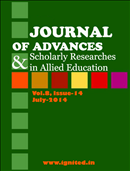A Study on Sculptural Art of Early Deccan
Exploring the Inner Experience of Indian Naturalism Through Sculptural Art in Early Deccan
Keywords:
Indian naturalism, sculptural art, Early Deccan, cyclic vision of nature, capillary system, fluid, connected tubes, human intervention, visible world, innervationsAbstract
Indian naturalism, through various ages and withdifferent degrees, has always relied on the outer aspect of things as a meansand proof of understanding a preexistent inner situation within a cyclic visionof nature. In contrast, in a capillary system, one and the same fluid rises indifferent and connected tubes emphasizing on a linear view of understanding thehuman intervention with nature. The creative acknowledgement of this internaland living connectedness of an inner experience of nature and the visibleworld, by putting it into form, is a characteristic hallmark of Indiannaturalism. It comprises innervations as well as transubstantiation and can beseen palpably depicted in various images and not simply those representingnature.Published
2014-07-01
How to Cite
[1]
“A Study on Sculptural Art of Early Deccan: Exploring the Inner Experience of Indian Naturalism Through Sculptural Art in Early Deccan”, JASRAE, vol. 8, no. 15, pp. 0–0, Jul. 2014, Accessed: Nov. 29, 2025. [Online]. Available: https://ignited.in/index.php/jasrae/article/view/5316
Issue
Section
Articles
How to Cite
[1]
“A Study on Sculptural Art of Early Deccan: Exploring the Inner Experience of Indian Naturalism Through Sculptural Art in Early Deccan”, JASRAE, vol. 8, no. 15, pp. 0–0, Jul. 2014, Accessed: Nov. 29, 2025. [Online]. Available: https://ignited.in/index.php/jasrae/article/view/5316











